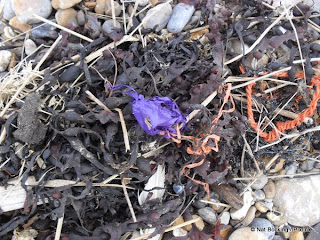The balloon industry widely claims that released latex balloons ascend into the upper atmosphere where they freeze and burst into biodegradable and harmless microscopic fragments falling over a wide area. However recent research says that actually 80% of the balloon will remain intact and 10% of the balloons released won't burst at all.
I don't need to argue with them the merits of all the scientific research because walking 100 metres of Dunwich Beach I found seven balloons with strings and valves that can choke sea turtles and sea-birds (who feed on jellyfish) and farm animals. Even if every measure is taken to reduce the risk of harm, i.e. not attaching strings or tags, which evidently almost never happens in the hundreds of balloon release photos and videos published each year, a balloon release is PLAIN AND SIMPLE LITTERING.
Sorry for shouting but that simple point seems to be missed by every public relations apologist and churnalist promoting each balloon release reported in the media, usually for good causes. Every officially sanctioned balloon release seems to encourage thousands more imitators who use strings and mylar balloons that compounds the harm of littering with animal cruelty and causing power blackouts. Let's leave aside the waste of helium gas but it is common sense that something in limited supply would be better used in life saving MRI scanners rather than balloon releases to raise "awareness" for ten seconds and to raise money which others elsewhere have to spend on cleaning them up.
Dunwich Beach is in an area of outstanding natural beauty. The rangers working for various agencies in the area; Natural England, RSPB and Forestry Commission tell me balloon litter is a serious nuisance. They are constantly picking up balloon litter caught in fences and trees, a time consuming process stretching their limited resources. Also the degraded latex leaves a sticky residue, the colour dye leaches out and stains the ground. With those I found on Dunwich Beach, the dye was as durable as permanent marker.
How many tonnes of litter does seven balloons per 100 metres add up to on the 18,000 km coastline of the UK? Well I reckon at least 2 million balloons at 12 grams per balloon comes to 24 tonnes which is two council rubbish lorries full and there must be hundreds of tonnes of litter falling to earth elsewhere. When these balloons land in water or on land they can kill years later. The national Beachwatch survey back in 2006 put the amount of litter rising from 3 sites of balloon litter per square kilometre to 10 per sq km in just ten years. I have seen no evidence yet that this trend has stopped or reversed.
More evidence and links are in a previous post. Follow #balloonrelease on twitter to make a difference. Tweet a link to this page with tinyurl.com/sufkbeach









No comments:
Post a Comment